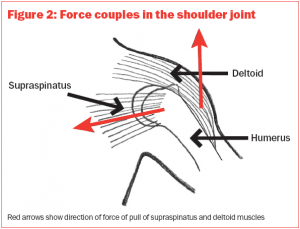Supraspinatus: Anatomy and Biomechanics
Supraspinatus (SSP) is one of the four rotator cuff muscles. It originates in the supraspinatus fossa, superior portion of the scapula (shoulder blade), just above the spine of the scapula. It passes laterally underneath the acromion process to insert in the superior facet and superior ½ of middle facet of greater tubercle of humerus, (Minagawa et al 1998).
Structure
Supraspinatus muscle has two bellies; anterior and posterior. The anterior belly has a cross-sectional area of 140 ± 43mm2 compared to posterior belly, which is calculated to be 62±25mm2. However, their tendon cross section areas were 26.4 ± 11.3mm2 and 31.2 ± 10.1 mm2 respectively. This data suggests that a larger anterior muscle pulls through a smaller tendon area causing significantly greater anterior tendon stress compared to posterior tendon stress, ( Roh et al., 2000). The anterior belly has an intramuscular fusiform core tendon, whereas the posterior belly is strap-like with no intramuscular tendon. Therefore, the fact that anterior muscle belly with a larger fusiform cross-sectional area and an intramuscular fusiform core tendon is responsible for the major contractile force generation by the supraspinatus, which is primarily responsible for arm abduction and humeral head depression, ( Roh et al., 2000).
Function
Given the origin and insertion of Supraspinatus, it was thought to be the abductor, mainly initial abductor of the arm. Contrary, to the early views, SSP is active throughout all ranges of arm elevation. Beyond 15 degrees the deltoid muscle becomes the main abductor.
Supraspinatus primarily works as a part of rotator cuff muscles; Supraspinatus, Infraspinatus (ISP), Teres Minor (TM) and Subscapularis (SSc). The primary function of the rotator cuff is to keep the head of the humerus depressed and centered into the glenoid fossa permitting a single center of rotation, while allowing efficient abduction or forward elevation of the arm (Saha 1971, Basmajian et al., 1959). This centering in the glenoid by the cuff is achieved by balancing the force couples around the glenohumeral joint. 
At the end range of shoulder motion (abduction and maximum external rotation), the capsulo -ligamentous structures such as the inferior glenohumeral ligament contribute to shoulder stability. In the mid-range of shoulder motion, because the capsuloligamentous structures are lax, shoulder stability is mainly provided by the glenoid concavity and the compressive force generated by the rotator cuff muscles (concavity-compression effect). Lippit et al., 1993. During shoulder motion, both the anterior (subscapularis muscle) and posterior (infraspinatus and teres minor muscles) rotators contribute to keep the humeral head in the glenoid socket. Considering that the cross-sectional areas of the anterior and posterior rotators are approximately equal, it is understandable that the torques generated by these groups are balanced and represent a force couple that resists humeral head translation, (Nobuyuki et al., 2015).
Nerve and blood supply
Suprascapular nerve, C5 & C6, superior trunk of brachial plexus
Suprascapular artery
Deficiency of supraspinatus
Terrier et al., (2007), reported that the deficiency of SSP may increase upward migration of the humerus, the eccentric loading, and the joint and muscle forces, which may cause a limitation of active abduction and degenerative glenohumeral changes (OA, and the RCT).
However, unlike the other cuff muscles, the supraspinatus (along with the deltoid) contributes to a slight superior translational force on the humeral head rather than a downward force, particularly at the initial angles of arm elevation. Although strengthening the supraspinatus might seem to facilitate impingement, the amount of the total muscle force that contributes to superior translation is only 4%, whereas the remaining 96% of the total force production provides compression. This compressive force centers the humeral head in the glenoid fossa providing a stable pivot point, (Wendy el al., 2002).
Mechanical function of Supraspinatus
The ability of a muscle to generate a torque about the joint is dependent on its mechanical leverage. Mathematically, torque is the product of force and the moment arm length. The larger a muscle’s moment arm, the greater its capacity to generate torque required to produce motion and counteract external loads. However, when a muscle’s lever arm is decreased, it must generate a larger amount of force to compensate for the diminished mechanical leverage, (Wendy el al., 2002).
Otis et al., 1994, studied the moment arm length of supraspinatus on 10 fresh frozen cadavers by measuring muscle excursion with known torques applied to the arm. The results showed a moment arm length of 2.5 cm for the anterior portion of the supraspinatus during abduction in neutral rotation. With the arm in the internal rotation, the abductor moment arm of the supraspinatus decreased from 2.5 to 2.2 cm, which is consistent with the tendon having dropped slightly from the top of the humeral head. With the arm in the external rotation, the abductor moment arm length increased to 2.8 cm. The results of Otis et al are consistent with results of a recent in vivo MRI study that found the moment arm length of the supraspinatus with the arm in neutral rotation and 0° abduction to be 2.4 cm, and 2.6 cm at 34° abduction with slight external rotation (Juul Kristensen et al., 2000).
NEXT: Supraspinatus strengthening
